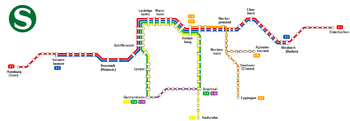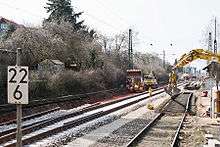Rhine-Neckar S-Bahn
The Rhine-Neckar S-Bahn forms the backbone of the urban rail transport network of the Rhine Neckar Area, including the cities of Mannheim, Heidelberg and Ludwigshafen.
The S-Bahn operates over 320 km of route in the states of Rhineland-Palatinate and Baden-Württemberg, and in small sections in Saarland and Hesse. S-bahn trains operate about 6 million kilometres per year, with 105 stations are served by 40 Class 425.2 Electric multiple units.
Network

The S-Bahn is about 290 km long and is one of the largest S-Bahn networks in Germany. The core area is in the states of Rhineland-Palatinate and Baden-Württemberg. At Homburg (Saar), it touches the Saarland and it has three stations in Hesse between Neckarsteinach and Hirschhorn. Four of the six lines run together on the core Schifferstadt–Ludwigshafen–Mannheim–Heidelberg section, with five branches to Homburg, Osterburken, Karlsruhe, Germersheim and Eppingen.
Services operate on weekdays at intervals of 30 or 60 minutes. The class 425 electric multiple units have a toilet and have fewer doors than class 423s. They have a floor height of 780 mm. The lines are shared with the other passenger and freight traffic. Services operate at regular intervals and the stations have been consistently upgraded for barrier-free access.
| Line- number | Route | Length | Stations | Railway lines |
|---|---|---|---|---|
| S 1 | Homburg (Saar) – Osterburken Homburg (Saar) – Kaiserslautern – Neustadt (Weinstraße) – Schifferstadt – Ludwigshafen (Rhein) – Mannheim – Heidelberg – Neckargemünd – Eberbach – Mosbach (Baden) – Osterburken |
200 km | 51 | Palatine Ludwig Railway, Rhine Valley Railway, Neckar Valley Railway, Neckarelz–Osterburken line |
| S 2 | Kaiserslautern – Eberbach (– Mosbach (Baden)) Kaiserslautern – Neustadt (Weinstraße) – Schifferstadt – Ludwigshafen (Rhein) – Mannheim – Heidelberg – Neckargemünd – Eberbach (– Mosbach (Baden)) |
110 km (133 km) | 31 (36) | |
| S 3 | Germersheim – Karlsruhe Germersheim – Speyer – Schifferstadt – Ludwigshafen (Rhein) – Mannheim – Heidelberg – Wiesloch-Walldorf – Bruchsal – Karlsruhe |
104 km | 25 | Schifferstadt–Wörth railway, Palatine Ludwig Railway, Rhine Valley Railway |
| S 33 | Bruchsal – Germersheim Bruchsal – Graben-Neudorf – Philippsburg – Germersheim |
32 km | 11 | Bruhrain Railway |
| S 4 | Germersheim – Bruchsal Germersheim – Speyer – Schifferstadt – Ludwigshafen (Rhein) – Mannheim – Heidelberg – Wiesloch-Walldorf – Bruchsal |
83 km | 27 | Schifferstadt–Wörth railway, Palatine Ludwig Railway, Rhine Valley Railway |
| S 5 | Heidelberg – Eppingen Heidelberg – Neckargemünd – Meckesheim – Sinsheim (Elsenz) – Eppingen |
43 km | 17 | Elsenz Valley Railway, Steinsfurt–Eppingen line |
| S 51 | (Heidelberg –) Meckesheim – Aglasterhausen (Heidelberg – Neckargemünd –) Meckesheim – Aglasterhausen |
19 km (39 km) | 7 (14) | (Elsenz Valley Railway,) Meckesheim–Neckarelz line |
Operating pattern
All lines have a 60-minute basic frequency. As a result of largely overlapping alignments in the core area services run at half-hourly frequency. On the core line between Schifferstadt and Heidelberg four lines run, each at hourly intervals, but due to problems of coordination may not provide a pure 15-minute interval schedule. Ludwigshafen-Rheingönheim and Ludwigshafen-Mundenheim are not usually served by lines S1 and S3. Line S1 usually serves Mannheim Rangierbahnhof and Mannheim-Seckenheim. On Saturday afternoons and Sundays, S2 from Kaiserslautern terminates in Heidelberg and S4 runs only between Germersheim and Mannheim.
Although the lines run from 05:00 until 01:30, regular interval operations usually run only between about 08:00 and 21:00.
History



On 14 December 2003, the Rhine-Neckar area became the last large densely populated area in Germany with an S-Bahn system—planning had lasted decades and involved the cooperation of the states of Baden-Württemberg, Hesse and Rhineland-Palatinate. Following European-wide advertising for tenders, operation for 12 years until 2015 was awarded to DB Regio.
First stage of development
Beginning in 2001, the lines and stations were prepared for S-Bahn operations. € 260 million was invested for construction and €190 million for vehicles. An extra bridge was built over the Rhine between Mannheim and Ludwigshafen, urgently required to increase capacity, a by-pass of Schifferstadt for long-distance traffic and Ludwigshafen-Mitte S-Bahn station in Berliner Platz. A new S-Bahn workshop was established near Ludwigshafen Hauptbahnhof.
It was considered important to provide a large amount of uniform equipment at the stations. The platforms were raised to 760 mm and made accessible by the disabled, partly via elevators. They received new platform equipment, such as waiting rooms and seating.
The platforms at Mannheim-Seckenheim, Mannheim-Rangierbahnhof, Ludwigshafen-Mundenheim and Ludwigshafen-Rheingönheim were raised temporarily using wooden planks, since no decision had been made on the final configuration of the track or the future position of the platforms.
Extension to Germersheim
The first stage was completed at the end of 2006 with the extension from Homburg to Kaiserslautern and the Mannheim-Speyer route to Germersheim. The Speyer route required electrification south of Schifferstadt and modification of three stations. A new station is under construction at Speyer Süd, but its opening has been delayed. A further extension from Germersheim to Graben-Neudorf to Bruchsal was opened in December 2011 and an extension of line S5 of the Karlsruhe Stadtbahn from Wörth am Rhein to Germersheim was opened in December 2010.
Extension to Homburg (Saar)
The extension of the Mannheim-Kaiserslautern line (Palatine Ludwig Railway) to Homburg was carried out as an urgent project in preparation for the 2006 FIFA World Cup. However, it was not finished in time and services commenced in December 2006. Only line S1 runs to Homburg; S2 continues to terminate in Kaiserslautern.
Second stage
Since December 2009 the new S5 line has run from Heidelberg on the Elsenz Valley Railway to Sinsheim and hourly on the Steinsfurt–Eppingen line to Eppingen. Trains only occasionally stop at Schlierbach/Ziegelhausen and Orthopädie for scheduling reasons. In June 2010 line S51 was established, from Meckesheim via the Schwarzbach Valley Railway every hour to Aglasterhausen.
Germersheim–Graben-Neudorf–Bruchsal
The Bruhrain Railway (Germersheim–Graben-Neudorf–Bruchsal) was extended from Germersheim to Bruchsal in December 2011. This required considerable modernisation and electrification between Graben-Neudorf and Germersheim. The new line was integrated into the 2011 timetable as "S33" (to avoid confusion with lines of the Karlsruhe Stadtbahn).[1] The cost of new infrastructure amounted to € 31.7 million. The upgrade began in early July 2010 and was completed for the December 2011 timetable change.[2][3]
Planned expansion

The S-Bahn was intended from the outset to have a second stage of development, to integrate additional cities and regions into the network. The schedule set out in the Realisierungsprogramm 2010 for the second stage to be completed between 2008 and 2010, was rejected in 2006. Planning is continuing, however, and the additional lines may be completed in 2010-2015.
Expansion of the Rhine Valley Railway
Due to the high utilisation on the Rhine Valley line on the Bruchsal–Heidelberg section it is planned to extend the platforms from 140 to 210 metres, so that longer trains can run.[4]
Mannheim–Schwetzingen–Karlsruhe
This would create a new S3 service in both the RheinNeckar S-Bahn and the Karlsruhe Stadtbahn using the Rhine line on the Mannheim–Schwetzingen–Graben-Neudorf–Karlsruhe route on the right (east) bank of the Rhine. The alignment depends on the decision over the proposed Frankfurt–Mannheim high-speed railway – a bypass solution with a new ICE station would favour an alignment via Mannheim-Seckenheim over Mannheim-Rheinau.
Mainz–Worms–Mannheim–Sinsheim–Eppingen/Aglasterhausen
In the southern section of electrification and reconstruction of platforms is complete. Since December 2009, the S-Bahn has run from Heidelberg on the Elsenz Valley Railway to Sinsheim or hourly on Steinsfurt–Eppingen line to Eppingen (line S5). Since June 2010, the S51 has run on the Schwarzbach Valley Railway to Aglasterhausen. In Eppingen there is a connection to the Karlsruhe Stadtbahn. Services will connect in Sinsheim with the Heilbronn Stadtbahn to Heilbronn, which is planned to open in 2012.
In 2015, the two new S-Bahn lines are planned to be extended from Heidelberg to Mannheim, running non-stop between Heidelberg Hauptbahnhof and Mannheim Hauptbahnhof.
South Hesse
Another new S-Bahn service is planned to connect Mannheim to the Hessian Ried and the Bergstraße. Two sections, Biblis–Mannheim Mannheim–Frankfurt railway and Mannheim-Weinheim–Darmstadt (Main-Neckar line), are to be combined to minimise traffic conflicts at Mannheim Hauptbahnhof, in order not to exacerbate limited capacity there.
New stations are planned at Bensheim-Süd, Weinheim-Süd and Neckarhausen and possibly at Pfungstadt-Süd and Weinheim-Sulzbach.
The creation of this new service is problematic:
- Both the Ried Railway and the Main-Neckar line carry long-distance, regional and goods traffic and the lines are at the limit of their capacity. Since the opening of the Cologne-Frankfurt high-speed line, in particular, traffic on the double-track Ried Railway has increased and causes substantial problems for regional traffic. While a proposal to convert the Riedbahn to four tracks was rejected many years ago, it is currently proposed to construct a new Rhine/Main-Rhein/Neckar high speed line. This project was once planned to be completed in 2007, but an agreement about the route has only recently been achieved.
- The planned connection of the two branches to Biblis and Darmstadt in Mannheim (creating a U-shaped curve) is intended to reduce traffic conflicts, not to cater for traffic demand, and will force passengers not bound for stations between Ludwigshafen Hbf and Mannheim Seckenheim to transfer. An improvement to the capacity in the Mannheim area (as now planned in connection with the new high speed line) would allow better connections, which are still under discussion.
- Integration with the Hesse and/or RMV services at Biblis (in addition to Darmstadt) has not been agreed. The use of the S-Bahn to Biblis would clearly be higher, if a connection could be made with the Rhine-Main S-Bahn line S7. An extension of the S7 from Riedstadt Goddelau to Biblis (and possibly Worms) was previously discussed. An isolated cost-benefit analysis produced an unfavourable result, but a comprehensive investigation on the effect of linking the two S-Bahn systems at Biblis has not been carried out.
Notes
- ↑ "Die neue Linie S33 zwischen Germersheim und Bruchsal". S-Bahn RheinNeckar. 10 November 2011. Retrieved 12 December 2011.
- ↑ "S-Bahn Rhein-Neckar – Netz wird weiter ausgebaut" (in German). VRN. Retrieved 16 January 2011.
- ↑ "S-Bahn Rhein-Neckar: Ausbau zwischen Bruchsal und Germersheim" (in German). Eurailpress. 14 January 2010. Retrieved 16 January 2011.
- ↑ "Der "Renner" S-Bahn sorgt für Kontroversen" (in German). Rhein-Neckar-Zeitung im Web. 26 September 2008. Retrieved 16 January 2011.
References
- Werner Schreiner: ... an einem Strang. Ludwigshafen am Rhein 2004, ISBN 3-934845-17-7 (in German)
External links
| Wikimedia Commons has media related to Rhine-Neckar S-Bahn. |
- "Rhine-Neckar S-Bahn website" (in German). Deutsche Bahn. Retrieved 16 January 2011.
- "Verkehrsverbunds Rhein-Neckar website" (in German). Retrieved 16 January 2011.
- "Line map of Rhine-Neckar S-Bahn" (PDF, about 150 kB) (in German). Retrieved 16 January 2011.


